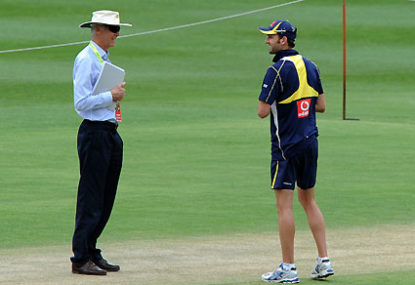The new National Selection Panel may have dodged some selection bullets coming into the second Test in Hobart via injuries, but you now have to wonder if the time to start the rebuilding program properly is here.
The loss to New Zealand will stick in the Australian team’s craw for some time, as it should. As well as New Zealand bowled, and Doug Bracewell in particular, Australia’s batting performance throughout the Test must become their line in the sand. There can be no going back over that line again.
I’ve never been big on making wholesale changes to a losing side. I’ve never really seen the point in flicking four or five or more players in one go when the week before they were the best guys for the job. A tweak or two here and there can add a spark, but mass changes can only destabilise a side.
Or so I thought.
The interesting situation the selectors find themselves in now is one of a losing side, numerous out-of-form players, and several other players returning from injury. We may have had two of those scenarios in the last few years, but not all three at the same time.
So the question for John Inverarity and his new selection panel cohorts becomes one of when exactly do they start leaving their mark on the side? Yes, they picked James Pattinson, Mitchell Starc, and David Warner for their Test debuts in the Trans-Tasman series, but all three were known entities, having already worn the national colours under the Hilditch reign.
Injuries, again, will dictate the extent of changes for Boxing Day. But, if the panel is serious about picking the best eleven cricketers in Australia – and the Argus report which established their being says they must be – we could be looking a vastly different batting order.
The time to start making the mark is here.
Phillip Hughes seems doomed, having even lost the support of his Captain now. Michael Clarke admitted in the Hobart post-match that “…he needs to find some runs; it’s as simple as that. If he’s not making them for Australia he’s going to have to go back and score some for New South Wales.”
There is a small issue here in that NSW don’t actually play again until February, but that’s out of Clarke’s and Hughes’ hands. Hughes needs to make runs somewhere. His just-announced 2012 deal with Worcestershire is quite timely, too; Australian duties are now unlikely to preclude him from having a full season at New Road.
Usman Khawaja may or may not be under the pump again. Shaun Marsh’s fitness remains an ongoing concern, and his unlikely return for Boxing Day should mean that Khawaja holds his spot. I say ‘should’ because another Ed Cowan score in Canberra next week might just fortify the case for his selection.
Khawaja is a funny place, stats-wise. In his six Tests, he averages 29.2, with his Johannesburg 65 his highest score. In 11 innings, he has seven scores above 21, yet only one fifty. A 0no and a 7 are his only single-figure scores. He’s making starts, but hasn’t quite gone on. He’s clearly a Test-quality batsman, but he just hasn’t fully grasped his chance yet. He needs to soon.
The Ricky Ponting and Michael Hussey equations get murkier by the day. If immediately following the lost Ashes series was the first opportunity, the New Zealand loss has also suddenly re-opened a small window for “Invers” and co to draw the curtains on two wonderful careers.
They could, if they were serious, pick their team for the first 2013 Ashes Test now. And on that front, I can’t see how Ponting, Hussey, or even Brad Haddin and Ryan Harris can last that long.
Yet the first three will almost certainly be picked next week, and if he’s fit enough, Harris will be too.
Ponting’s battles are well documented. Since starring throughout the Ashes series and again in Sri Lanka, Hussey has averaged less than 12. Haddin can only be holding on because of Tim Paine’s ongoing injury, and continues to bat like that super-talented but brain-explosion-prone 19 year-old I first saw in Canberra in the late 90s. Harris, by his own admission, is a Test-to-Test proposition.
Shane Watson, too, is an all-but certainty to play in Melbourne, yet he won’t have played for five weeks, and won’t be fit enough to bowl. But if he’s not fit enough to bowl, his batting hasn’t exactly been superlative lately either. So then why rush him back?
The argument will be made that a side in transition needs some experienced heads to guide them through their fledgling days in Test cricket, but this ignores the fact that the last three Man of the Match awards – popularity contests aside – have gone to an 18yo debutant, a 21yo debutant, and a 23yo in his second Test. The kids don’t need their hands held; they’re already doing the holding themselves.
Clarke, Siddle, Watson are experienced heads. Warner, Khawaja, Marsh, Paine, Pattinson, and Starc have all been in and around the Australian set-up for a few years. Cowan has worn a state cap for eight or nine seasons. Moreover, it’s not like we’re playing 14 year-olds in 2nd or 3rd Grade here; this is Test Cricket, and it’s not supposed to easy by its very name and definition.
If the selectors were serious, they’d draw their line in the sand after Hobart and let a batting order of Warner, Cowan, Khawaja, Clarke, Watson, Marsh/Dan Christian, and Matthew Wade loose on the Indian attack on Boxing Day.
Sadly, for the future at least, injury constraints and a touch of gun-shyness will probably mean that a Watson-for–Hughes straight swap is the sum total of the Hobart fallout.





























































































